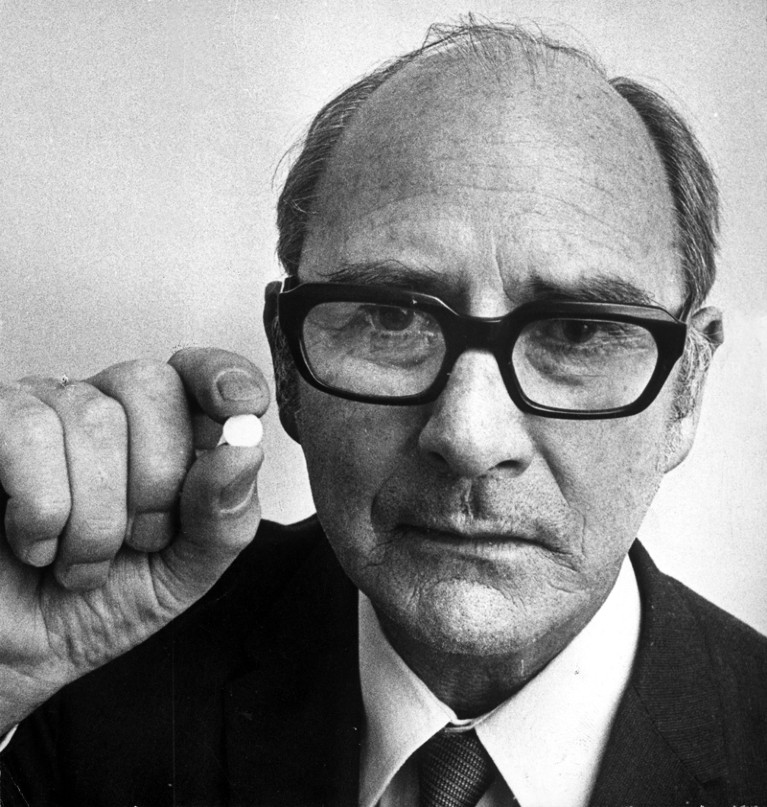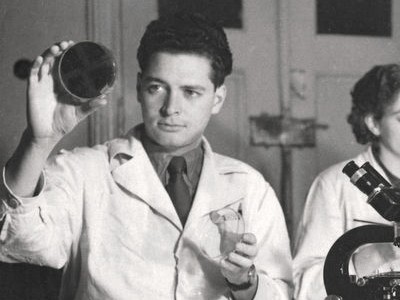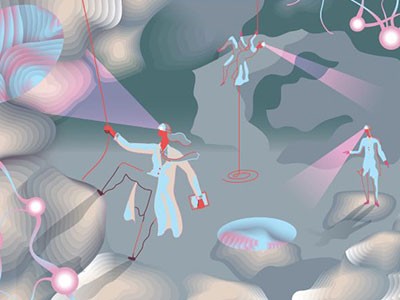
John Cade, pictured in 1974, was the first person to test lithium as a treatment for biopolar disorder.Credit: News Ltd/Newspix
Lithium: A Doctor, a Drug, and a Breakthrough Walter A. Brown Liveright (2019)
Some 70 years ago, John Cade, an Australian psychiatrist, discovered a medication for bipolar disorder that helped many patients to regain stability swiftly. Lithium is now the standard treatment for the condition, and one of the most consistently effective medicines in psychiatry. But its rise was riddled with obstacles. The intertwined story of Cade and his momentous finding is told in Lithium, a compelling book by US psychiatrist Walter Brown.
Bipolar disorder, labelled manic-depressive illness until 1980, affects around 1 in 100 people globally. Without treatment, it can become a relentless cycle of emotional highs and lows. Suicide rates for untreated people are 10–20 times those in the general population. Fortunately, lithium carbonate — derived from the light, silvery metal lithium — can reduce that figure tenfold.
Probing the genetics of the mind
Brown’s telling of Cade’s eventful life covers much of the same ground as Finding Sanity (2016), a rather hagiographic biography by Greg de Moore and Ann Westmore. What Brown does superbly well is to show that Cade made his discovery without access to advances in technology or to modern facilities — and almost despite them. His finding was the happy result of being forced to work with the simplest of means.
During the Second World War, Cade was interned for more than three years in the notorious Japanese prisoner-of-war camp at Changi in Singapore. He was put in charge of the psychiatric section, where he began to note the decisive link between certain food deficiencies and diseases in his fellow prisoners. A lack of B vitamins, for instance, caused beriberi and pellagra.
After the war, he pursued his investigations. Working from an abandoned pantry in Bundoora Repatriation Mental Hospital near Melbourne, Australia, he began to collect urine samples from people with depression, mania and schizophrenia, aiming to discover whether some secretion in their urine could be correlated to their symptoms. With no access to sophisticated chemical analysis and largely unguided by theory, Cade injected the urine into the abdominal cavities of guinea pigs, raising the dose until they died. The urine of people with mania proved especially lethal to the animals.
Drug discovery: A life of tumult and triumph
In further experiments at Bundoora, Cade found that lithium carbonate — which had been used to treat conditions such as gout since the nineteenth century — reduced the toxicity of patients’ urine. Cade also noticed that a large dose of the medication tended to calm the guinea pigs. He could turn them on their backs, and the normally restive rodents would gaze placidly back at him. He wondered whether lithium could have the same tranquillizing effect on his patients. After trying it out on himself to establish a safe dose, Cade began treating ten people with mania. In September 1949, he reported fast and dramatic improvements in all of them in the Medical Journal of Australia (J. F. J. Cade Med. J. Aus. 2, 349–351; 1949). The majority of these patients had been in and out of Bundoora for years; now, five had improved enough to return to their homes and families.

Lithium carbonate is now on the World Health Organization’s list of essential medicines.Credit: Charles D. Winters/Science Photo Library
Cade’s paper went largely unnoticed at the time. Soon, moving along the rows of the periodic table like a beachcomber on a shore, Cade began to experiment with salts of rubidium, cerium and strontium. None proved therapeutic. In 1950, he also abandoned his experiments with lithium. The therapeutic dose of lithium is dangerously close to a toxic dose, and that year one of his patients — “W.B.”, a man with a 30-year history of bipolar disorder — appeared in the coroner’s records as having died from lithium poisoning.
Brown also weaves in the story of Mogens Schou. The Danish psychiatrist was as much a hero as Cade, fighting long and hard to get lithium accepted as a treatment for bipolar disorder. He knew the condition intimately, because his brother had it. Starting in the 1950s, Schou teamed up with fellow psychiatrist Poul Baastrup to conduct a series of lithium experiments with ever stricter conditions, culminating in a double-blind, placebo-controlled clinical trial. Published in 1970 in The Lancet, this established beyond doubt that lithium was effective for most people with bipolar disorder, including Schou’s brother (P. C. Baastrup et al. Lancet 296, 326–330; 1970).
Today, lithium helps to stabilize the moods of millions of people with the condition, although the dose must be carefully controlled and it can have unpleasant side effects, such as nausea and trembling. Its mechanism is still something of a mystery. Most research targets the delicate chemistry supporting the functioning of neurotransmitters; but as yet, definitive results are lacking. Nor has the cause of the disorder been established. It is clear that there is a genetic component: if one of a pair of monozygotic twins (who share all their genetic material) has the disorder, there is around a 60% chance that the other will have it. In dizygotic twins, the figure is 10%.
Finishing Lithium, readers are left with a sense of paradox. The drug that set off the ‘psychopharmacological revolution’ of the 1950s, with antipsychotics and antidepressants arriving in its wake, is in many ways a stunning success. Yet it was developed in a ramshackle pantry, and the bottled urine samples were stored in the Cade family refrigerator. Moreover, in retrospect, the discovery of lithium seems in part related to an erroneous interpretation on Cade’s part. The ‘tranquillized’ guinea pigs were probably showing the first symptoms of lithium poisoning: lethargy is still a warning sign of an overdose. And the step from guinea pigs to humans was a “conceptual leap”, as Brown kindly puts it — hardly a deduction from sound theory. It is unlikely that a modern researcher would get permission for experiments such as Cade’s.
Cade’s findings could easily have foundered if Schou and others, such as US medical researcher John Talbott, hadn’t followed up on his 1949 paper. Thus, hailing Cade as a trailblazer is valid — but without Schou and the rest, there would be no trail. Thanks to them all, this ubiquitous element, easily manufactured and never patented by pharmaceutical companies, remains both cheap and invaluable as a treatment for a troubling disorder.


 The sorrows of psychiatry
The sorrows of psychiatry
 Probing the genetics of the mind
Probing the genetics of the mind
 Drug discovery: A life of tumult and triumph
Drug discovery: A life of tumult and triumph







